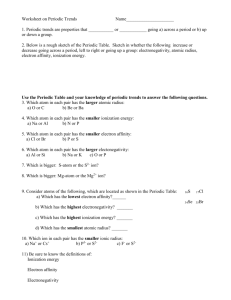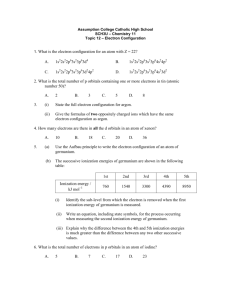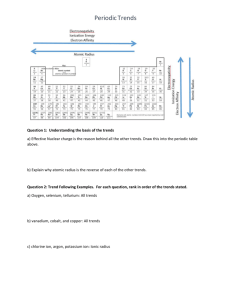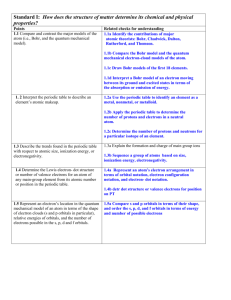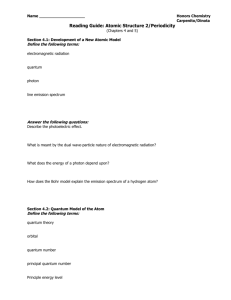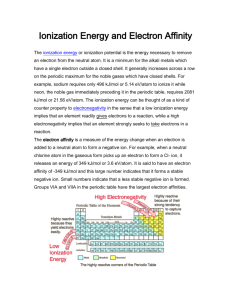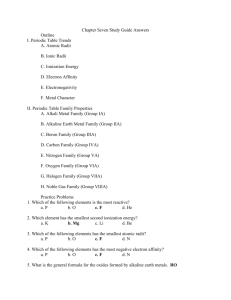Laude's CH301 Worksheet 2: Electronic Structure, Periodicity and
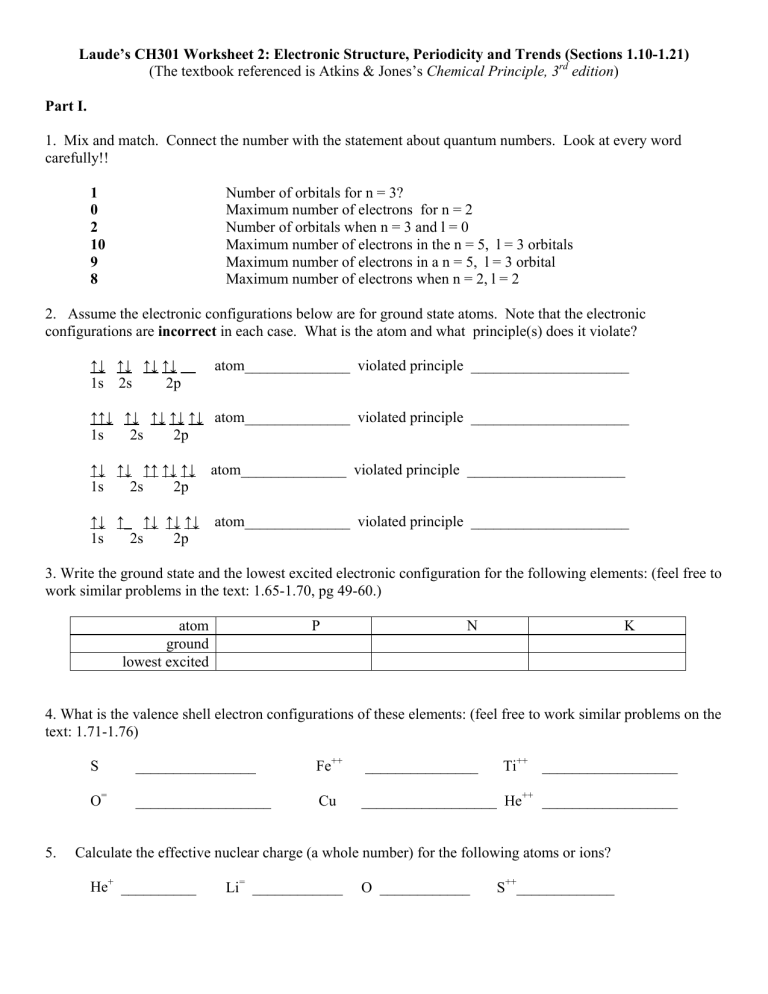
Laude’s CH301 Worksheet 2: Electronic Structure, Periodicity and Trends (Sections 1.10-1.21)
(The textbook referenced is Atkins & Jones’s
Chemical Principle, 3 rd
edition
)
Part I.
1. Mix and match. Connect the number with the statement about quantum numbers. Look at every word carefully!!
1
Number
0 for
Maximum number of electrons for n = 2
2
10
Number of orbitals when n = 3 and l = 0
Maximum number of electrons in the n = 5, l = 3 orbitals
9
8
Maximum number of electrons in a n = 5, l = 3 orbital
Maximum number of electrons when n = 2, l = 2
2. Assume the electronic configurations below are for ground state atoms. Note that the electronic configurations are incorrect in each case. What is the atom and what principle(s) does it violate?
↑↓ ↑↓ ↑↓ ↑↓ ↑↓ atom______________ violated principle _____________________
1s 2s 2p
↑↑↓ ↑↓ ↑↓ ↑↓ ↑↓ atom______________ violated principle _____________________
1s 2s 2p
↑↓ ↑↓ ↑↑ ↑↓ ↑↓ atom______________ violated principle _____________________
1s 2s 2p
↑↓ ↑ _ ↑↓ ↑↓ ↑↓ atom______________ violated principle _____________________
1s 2s 2p
3. Write the ground state and the lowest excited electronic configuration for the following elements: (feel free to work similar problems in the text: 1.65-1.70, pg 49-60.) atom P N K ground lowest excited
4. What is the valence shell electron configurations of these elements: (feel free to work similar problems on the text: 1.71-1.76)
Fe ++ _______________ Ti ++ __________________
O = __________________ Cu __________________ He ++ __________________
5. Calculate the effective nuclear charge (a whole number) for the following atoms or ions?
He + __________ Li = ____________ O ____________ S ++ _____________
6. For the following pairs of atom or ions, fill in the blank with either < or > to correctly order the identified periodic trend.
Atomic radius Si __ Cl Br __ I Au __ Hf Mg __ Cd
Ionization Potential Na __ K He __ H N __ O Al __ Mg
Ionic Radius K + __ Cs + F __ Ne Ar __ K + Al +3 __ N -3
Electron Affinity Cl __ I O __ F Na __ Mg H __ He
Part II.
Thought questions for the thoughtful—show that you really know your stuff by creating the periodic table for an entire new set of quantum rules.
1. Suppose someday you are able to come through a black hole to a different world, in which the atoms are built up in a slightly different fashion from our good ol’ universe. In the new universe there are three electrons in each orbital and there are only 2 sub levels x and y, each with 2 orbitals. Construct the periodic table through n
= 3 in the table below. For example, if you did it correctly, your “Fe” will have a configuration of 1x 6 1y 6 2x 6
2y 6 3x 2 .
Fill in elements H through Kr below n = 1 n = 2 n = 3
2. Read section 1.13 to understand how elements are placed where they are in the periodic table. Which elements in this new world do you expect to share the same chemical reactivity with “Fe”(read section 1.20 for this)? Would your element be considered more “metallic” or more “nonmetallic”? What elements would be least reactive? What are some likely salts that might form?
Least reactive elements? ___________________ Some likely salts ______________
3. Read sections 1.15, 1.16 and 1.17 to understand the trend in ionic radius, ionization energy as well as electron affinity as atomic number increases/decreases. Apply the fundamental principles to your own periodic table.
Now, compare the element “Na” and “S” to see which one has the larger radius, ionization energy and electron affinity. Fill in the blank with the appropriate < or > symbol.
Atomic Ionization
Na ______ S Na ______ S Na ______ S
4. Calculate the effective nuclear charge of “Fe” in your new world. (Re-read section 1.11 if needed)
